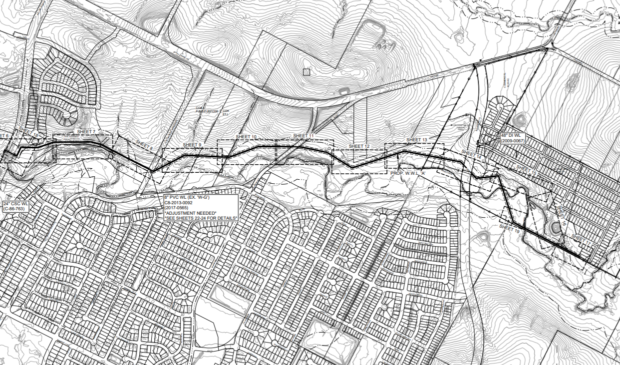Environmental Commission clashes over potential wastewater line near Marble Creek
Wednesday, November 20, 2019 by
Katherine Corley After a two-hour discussion on Nov. 6, the Environmental Commission recommended against a variance that would have allowed a developer to place an 860-foot portion of a large wastewater line within the inner half of the critical water quality zone encompassing Marble Creek in Southeast Austin. The variance will allow wastewater to run less than 150 feet from the center of the creek.
Developer Philip Boghosian had requested the variance as part of a plan to build a proposed mixed-use development of 340 single-family homes, 350 multifamily units and 30,000 square feet of office space on approximately 116.5 acres of his land, situated north and south of Slaughter Lane and west of Thaxton Road.
At the meeting, Jonathan Garner, environmental review program coordinator with the city’s Development Services Department, advised the Environmental Commission against approving the variance because of the “potential for leaks and breaks in the wastewater line that could result in sewage overflows” into Marble Creek. Garner also said that constructing the wastewater line by tunneling 8-12 feet into the earth would result in disturbance to native soils, vegetation and water flows underground.
Chris Herrington, environmental protection officer with the Watershed Protection Department, said an environmental review had determined that the wastewater line could be built with a different method that would avoid the critical water quality zone altogether. That method uses a powered lift station that moves water from lower to higher elevation instead of relying on gravity.
Herrington also noted that, while moving wastewater using lift stations can cost more than relying on gravity, the Environmental Commission’s job is to focus solely on which option is best for the environment.
“As a best practice, we want to strike a balance between maintaining a gravity sewer system, but also locating these wastewater lines outside of environmentally sensitive areas,” Herrington said. “Is there an alternative? Yes. … Would that alternative line be located further away from the creek than this line is being proposed? Yes.”
Attorney Jeff Howard and engineer Dan Ryan, who represented Boghosian at the meeting, said that constructing lift stations to reroute the wastewater line under the streets of a nearby neighborhood would increase the cost of the project by $1.5 million, which could add $8,000-$10,000 to the costs of the houses in the proposed development. Additionally, Howard and Ryan argued that wastewater lift stations are subject to mechanical failure and leaking and overflowing as well, and moreover, that the developer would have to obtain a new easement to build the lift stations.
“From an environmental standpoint, from an economic viability standpoint, (the lift station) alternative is not viable,” Howard said.
After each side’s formal presentation, the commissioners questioned both parties extensively. In an often-passionate exchange, commissioners debated whether they could take housing affordability into account, explored options to encase the wastewater line to reduce the risk of leakage and discussed the expected life cycle of gravity wastewater lines versus lift stations.
An initial motion that approved the variance with added conditions to increase environmental protection within the critical water quality zone, such as encasing the wastewater line, reducing construction access roads and avoiding manholes, barely failed.
Commissioner Mary Ann Neely expressed her concern that, by supporting the variance to locate the wastewater line in a critical water quality zone, the commission would be applying different environmental standards to different parts of town.
“We wouldn’t do that to Barton Creek,” Neely said. “We wouldn’t put any (wastewater lines) in any of the creeks on the north side or the west side, so why are we doing it here? I don’t think that’s the right thing to do just because it’s low-income people, to put something in the creek that we would not allow for even a minute in other areas of the city. And so that’s why I’m not supporting it. I don’t think it’s fair to the people there.”
Finally, the commission voted to recommend against allowing the variance in a vote of 7-1 with Commissioner Pam Thompson voting in opposition. Commissioners Andrew Creel and Curtis Smith abstained and Kathleen Coyne was absent.
The commission’s motion suggested that, if the Zoning and Platting Committee approved the variance anyway, it should append several added conditions to increase environmental protection within the critical water quality zone that were included in the earlier motion.
The date for the case to come before the Zoning and Platting Commission has not yet been set.
This story has been corrected to reflect the fact that the project is located in Southeast Austin. Map courtesy of the city of Austin.
The Austin Monitor’s work is made possible by donations from the community. Though our reporting covers donors from time to time, we are careful to keep business and editorial efforts separate while maintaining transparency. A complete list of donors is available here, and our code of ethics is explained here.
You're a community leader
And we’re honored you look to us for serious, in-depth news. You know a strong community needs local and dedicated watchdog reporting. We’re here for you and that won’t change. Now will you take the powerful next step and support our nonprofit news organization?







